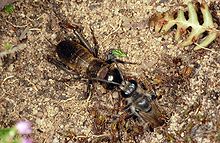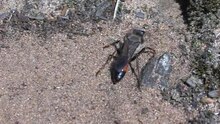Locust sand wasp
| Locust sand wasp | ||||||||||||
|---|---|---|---|---|---|---|---|---|---|---|---|---|

Locust sand wasp ( Sphex funerarius ) |
||||||||||||
| Systematics | ||||||||||||
|
||||||||||||
| Scientific name | ||||||||||||
| Sphex funerarius | ||||||||||||
| Gussakovsky , 1934 |


The locust sand wasp ( Sphex funerarius , Syn . : Sphex rufocinetus ) is a hymenoptera from the family of Sphecidae . The species is strong enough to sting a person with its sting.
features
The wasp reaches a body length of 16 to 25 millimeters (females) or 15 to 19 millimeters (males). The first abdomen segment is colored red, the rest of the abdomen is black. The wings are clouded and have a dark end edge. The legs of the females are partly red. The propodeum has a furrow on the side.
Occurrence
The species is widespread in North Africa, southern Europe and east to Mongolia. The northern limit of distribution runs through Germany, an isolated population on Gotland is the only one in Scandinavia and the northernmost occurrence of the species. It inhabits extensive, sparsely vegetated, open, sandy habitats and dry grasslands . The species flies in two generations from mid-June to early September. It is rare in Germany and only very locally known from climatically favorable regions. In the past, it showed significant fluctuations in stocks. Strong deposits from Franconia and Brandenburg were reported from the 19th century . Until the 50s of the 20th century. these reports were confirmed, evidence was also added from Baden . In the 1960s, the species seemed to have completely disappeared from Germany, until numerous finds became known again from the 1990s, especially in inland dune areas along the Upper Rhine Rift.
Way of life
The wasps especially fly to the sand thyme ( Thymus serpyllum ) to take in nectar. The females often lay their nests in communities, with the nest entrances close together in sandy or loamy soil. The main course runs at an angle and is about six inches long. Up to four side corridors branch off from it, each end with a cell. Usually three to five leaf locusts (Tettigonidae), but also real crickets (Gryllidae) are introduced per cell . In Germany, these are above all the common sickle insect ( Phaneroptera falcata ), oak horror , as well as the wart-bite ( Decticus verrucivorus ). The nest entrance is not closed while the female is hunting. The prey is transported to the nest in flight, with the mandibles holding the antennae and the middle legs holding the body with its belly facing downwards. Only rarely can the female wasp be seen bringing the prey to the nest on foot or jumping. The female first places the prey in front of the entrance and checks the nest, only then is the prey entered into the nest. The wasp larva hatches three to four days after egg-laying, which takes about 18 days to pupate. The imago hatches after a further 24 days .
Taxonomy
The locust sand wasp has long been known as a taxon and has been well delimited, but the name caused some confusion. In older works, the species is still listed as Sphex maxillosus F. 1793 , this name is preoccupied and therefore invalid, as it is a homonym (identical name) to a name introduced by Poiret in 1787 . Another name that has long been used for this species was Sphex rufocinctus Brullé in 1833 . After a more recent revision by Menke and Pulawski of the affected species group, this name turned out to be a synonym for the Mediterranean species Sphex flavipennis . The next available name was Sphex funerarius , introduced in 1934 , which has been considered the correct name since 2000.
supporting documents
- Blösch, M. (2000): Germany's digger wasps - Germany's animal world, 71. 480 pp .; Goecke & Evers, wine presses.
- Menke, AS and Pulawski, WJ (2000): A Review of the Sphex flavipennis Species Group - Journal of Hymenoptera Research: Vol. 9, No. 2: pp. 324-346.
- Rolf Witt: Wasps. Observe, determine. Naturbuch-Verlag, Augsburg 1998, ISBN 3-89440-243-1 .
Web links
- www.naturbildarchiv-guenter.de Photo report on nest building, entry of prey and laying eggs of the locust sand wasp Sphex funerarius
